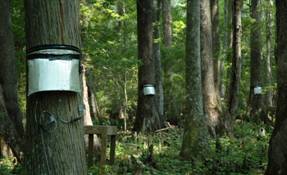Physiological Ecology and Ecohydrology
The form, function, and productivity of wetland communities are influenced strongly by the hydrologic regime of an area. Wetland ecosystems persist by depending upon surpluses of rainfall, evapotranspiration, soil moisture, and frequency and amplitude of water level fluctuations. Wetland vegetation can also influence ecosystem water budgeting through conservative water- and carbon-use strategies.
For example, scientists studying the physiological ecology of the Palmyra Atoll, a U.S. territory located in the Pacific Ocean, have found that sea-level rise, rainfall variability, and introduced plants are important factors driving changes on low-lying atolls. The National Wetlands Research Center is investigating whether root-zone competition for fresh water is an important factor allowing non-native coconut palms to expand into native Pisonia grandis forests. Palmyra is critical to researchers because it offers scientists an opportunity to study how undisturbed ecological communities are structured and function. In 2001, Palmyra's tidal lands, submerged lands, and surrounding waters were designated as a National Wildlife Refuge by the Department of the Interior to preserve the natural character of fish, wildlife, plants, coral reef communities, and other resources.
 Research
Research
- Sapflow and Water Use of Freshwater Wetland Trees Exposed to Saltwater Incursion in a Tidally Influenced South Carolina Watershed (Dr. Ken W. Krauss, Jamie A. Duberstein, Clemson University)
- Ecophysiological Proficiency of Tidal Freshwater Forested Wetlands: Investigating Landscape and Microtopographic Scales (Jamie A. Duberstein, Clemson University, Dr. Ken W. Krauss)
- Water Use Efficiency in Coastal Marsh Plants Transitioning to Mangrove in Ten Thousand Islands National Wildlife Refuge (Dr. Rebecca J. Howard, Dr. Ken W. Krauss)
- Characterizing Individual Tree Water Use of Black Mangroves (Avicennia germinans) at their Northern Latitudinal Limit (Dr. Karen L. McKee, Dr. Ken W. Krauss)
- Whole-tree Transpiration, Stand Water Use, and Growth of Pisonia grandis Trees on Palmyra Atoll, Line Islands (Dr. Ken W. Krauss)
- Individual Tree and Stand Water Use of Longleaf Pine and Bottomland Hardwoods at Bannockburn Plantation, South Carolina (Dr. Ken W. Krauss)
- Investigating Seasonal Patterns on Water Use of Vegetation along a Marsh-Marsh Ecotone in the Northern Everglades (Dr. Sharon M.L. Ewe, Dr. Ken W. Krauss)
- Sapflow Characteristics of Neotropical Mangroves in Flooded and Drained Soils (Dr. Ken W. Krauss, Dr. Thomas W. Doyle)
- Influence of Salinity, Tidal Amplitude and Hydroperiod on Herbaceous Marsh Vegetation Composition in Coastal Louisiana (Dr. Gregg Snedden)
Return to Coastal Restoration Assessment
Return to Forest Ecosystem